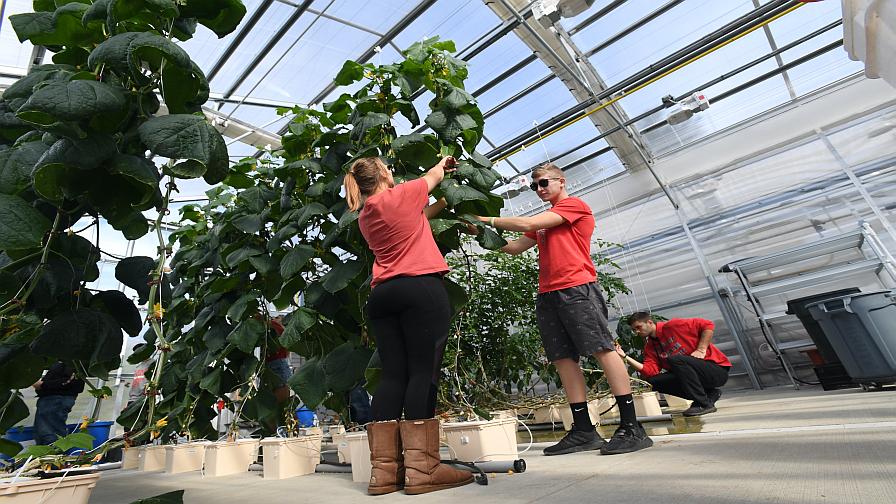The Ohio State University ATI Provides the Training Ground for Tomorrow’s Growers

Students at Ohio State University’s ATI campus in Wooster, OH, work in the new hydroponic crop production area. The new focus provides hands-on experience from seeding and production to post-harvest handling, and the output is sold to the campus cafeterias and culinary professionals. (Photo Courtesy – The Ohio State University)
I probably don’t need to tell you all this, but it bears mentioning here anyways: the world of horticulture is changing, and changing fast.
Cannabis and hemp are taking their place among the mainstream crops being grown indoors at commercial scale, and internally grown produce and vegetables are showing up on grocery store shelves as consumers demand more local options year-round.
Once-considered-niche production systems like fully controlled warehouse growing, automated container farming, hydroponic and vertical farming are gobbling up market share across the country. Growing indoors offers a host of benefits over field production, another fact I probably don’t have to explain to anyone reading this…
These novel production systems for creating quality plants indoors require new and evolving skill sets, so one of the country’s largest Ag Extension programs is stepping up to the plate with a new curriculum to help train tomorrow’s greenhouse growers.
A New Program for Students
Announced just this past week, the Ohio State University Agricultural Technical Institute (Ohio State ATI) is now offering a hydroponic crop production course as part of its two-year greenhouse management and greenhouse engineering technology specializations.
The coursework takes place in OSU’s technology-filled on-campus research greenhouses at ATI in Wooster, OH, where program lead Dr. Uttara Samarakoon recognized the need to diversify the program curriculum in response to what she calls a boon in indoor, hydroponic produce growers setting up shop in the Buckeye State.
I asked Dr. Samarakoon what changes had to be implemented to bring this new skill set training to OSU-ATI’s students.
“The production systems are different in hydroponic food crop production as compared to ornamental (production). The use of growing substrate is different, and the other differences are in post-harvest handling and food safety,” she says. “Over the last few years, we have established several different systems for the students to get hands-on experience, from seeding and production to post harvest handling.”
Samarakoon adds that during the hydroponic class, students work with multiple crops, multiple systems, and different production stages. “We also sell (the output) to our cafe and culinary staff at ATI.”
Having visited and toured the greenhouse facilities at OSU-ATI back in January during the University’s annual Greenhouse Management conference, I was immediately struck by the level of sophistication of the research greenhouses and the technology contained within for students to work with. Everything was seemingly top notch to this still-learning-Horticulture scribe, from the LEDs to the latest in automation from commercial suppliers like CropKing.
“The new facilities have provided these students the opportunity to experience the latest horticulture technology via installing and maintaining equipment,” Samarakoon says. “Instructors and students make use of facilities for labs and practicum experiences.”
Addressing Labor Challenges
What OSU-ATI is doing with this new curriculum in Wooster is important work. It seems no indoor growing operation is safe from the labor woes that have plagued this industry (and all of ag at large), and Dr. Samarakoon and her team of professors and graduate assistants are dead set on helping alleviate some of that pressure.
“ATI has provided greenhouse professionals to the industry many years and we continue to do so,” she says. “The advisory committee for the greenhouse program (consisting of industry members and OSU faculty) and other producers that I visit during the year provide input on the labor needs in our industry, and over the years we have made changes to our curriculum to cater to their needs. We strive to provide both the theoretical, as well as the practical skills required to be successful in this industry.”
The program head adds that, aside from the classroom and hands-on greenhouse instruction at ATI, the students also benefit from the University’ relationships with many of the commercial growing operations throughout the state. After internships and graduation, the students typically do just fine in securing work in the industry.
“Both our practicum and our many internship options provide an opportunity for our students to develop work ethics in addition to hands-on experience,” she says. “Most of our students find employment right out of college, and many internship employers hire the interns back on after completion of the degree. I always receive emails from greenhouse industries looking to hire from the Greenhouse program.”
The greenhouse programs at ATI-Wooster serve 650 students, providing affordable, accessible associates degrees that lead directly to employment, or bachelor’s degree opportunities.
*EDITOR’S NOTE: Unfortunately, due to the ongoing COVID-19 situation here in the U.S., ATI-Wooster campus along with OSU’s main campus in Columbus, OH, are currently closed to students, faculty, and visitors until at least March 30.
For more information on how COVID-19, aka CoronaVirus 2019, is impacting the horticulture industry, follow this link: https://www.greenhousegrower.com/tag/coronavirus/









